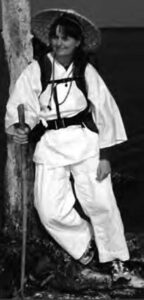DIRECTOR, KARIN MULLER
DISTRIBUTOR: WWW.JAPANLANDONLINE.COM
225 MINUTES, COLOR , TWO DVD SET, ALSO AVAILABLE IN VHS
Reviewed by Guven Witteveen

©2005 Karin Muller
Karin Muller’s Japanland book was published in 2005, and the double DVD set was released in 2006. Classroom supplements went online at japanlandstudyguide.com at the end of 2007. This review focuses on the four hours of short video segments that can be viewed as stand-alone pieces or played as a linear story that follows Muller’s year of observing and participating in mainstream Japanese life, as well as pursuing far less common experiences across the islands.
The story opens with Karin introducing herself and the judo training that brought her to Tokyo. She then ventures out to some places within easy reach of the capital. From her interest in the similarities to and difference with her life in the US, she sets off for several months across the islands to learn about ongoing traditions and everyday life among the Japanese people.
What Karin does not say is that she has made travels before and presented them through film. Her other work, along with still images, some commentary (www.japanlandjourney.com), and ordering information for the Japanland set are online at www.japanlandonline.com. The quality of the audio and video is high. The pacing of edits and the length of each segment are also well done. Her storytelling and production skills are clear. No prior knowledge about Japan is presumed. The opening menu on each DVD allows easy navigation to individual episodes, which run between two and eight minutes. The story flows in chronological order from one seasonal event to another, from one end of the main island to the other, and circling the Inland Sea island of Shikoku on its pilgrimage route.
A simple, powerful element she uses is to give the names of the people she meets and learns from along the way. Another is to try her hand at all sorts of activities, without introducing any exoticism to the unfamiliar things she is doing. Together, this naming and participation personalizes the viewer’s experience. One feels the subject is familiar—that one could step right into the same event, know the people involved, and understand a good deal about the activity’s main features.
Muller groups the segments into three broad types: scenes from urban life today, religious practices, and traditional arts and practices. Urban scenes include youth fashions and pastimes, the hub of activities at the train station, including the bicycle parking lot enforcement, full service gas station routines, the nighttime noodle vendor, a visit to the pachinko parlor and golfing decks, a neighborhood fire patrol, a night at a capsule hotel, and lives of homeless people. Muller visits Mt. Koya’s monastery, tagging along for a retreat with Yamabushi (mountain ascetics) and the eighty-eight pilgrimage stations around Shikoku with a group to demonstrate some religious practices. There is also a segment with a door-to-door itinerant lion dance troupe, as well as other festivals and ceremonies.
The third broad category of traditional arts and practices illustrates historical samurai commemorations, apprentice sword-making, wood-fired pottery making, fishing village life and the morning market, learning and performing taikō (festival drumming), and an annual village winter outdoor stage production.
This two-DVD set will be of greatest value to people seeking cultural literacy about Japanese social life. Students of Japanese language, exchange students past, present or future, as well as foreign residents will gain most from the presentations. Other audiences include social studies classes. There are also specific segments of interest to students of arts, music, and religions. The convenient form and the rich content of Japanland makes it a pleasure to view and to use. Teachers who would like to contact Karin Muller may reach her at karin@karinmuller.com.

